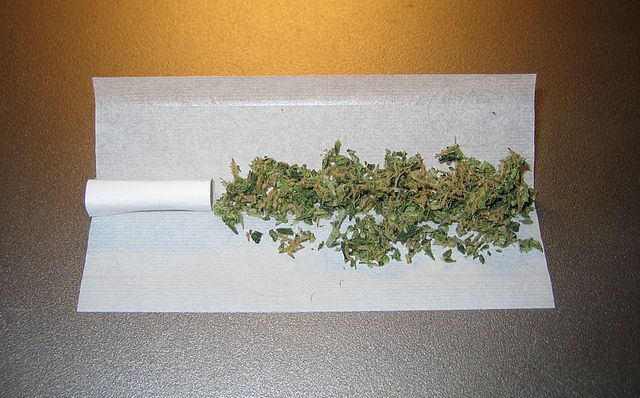It’s a potent, herbal smell, though it varies by location – the fraternity house porch, the back door of Goodwin-Kirk, the bush at the corner of 31st Street and Forest Avenue. The perpetrators are long gone, having fled to avoid legal consequences.
Police and Drake administration know it as marijuana or cannabis, but students use more colloquial names – weed, pot, bud, grass, hash. Recreational weed consumption isn’t legal in Iowa – nor is it legal anywhere for those under 21 – but that doesn’t prevent a vibrant cannabis culture from making its mark on campus.
“Ash” is a Drake junior and Fraternity and Sorority Life member who claims to be “very modest” with their weed consumption. Students interviewed for this article will be referred to using aliases to protect them from social or legal consequences.
“On a college campus, it’s inevitable that there’s an introduction to weed,” Ash said. “It’s a very big part of campus culture.”
Weed consumption has diversified from the joints and pipes used by hippies depicted in 1970s political advertisements. Beginners are faced with a cornucopia of products ranging from resins and vape-like carts to edibles and bud. Bud (also known as flower) consists of ground cannabis flowers consumed using pipes, water-based apparatuses called bongs, rolled joints or refilled cigars known as blunts.
“Dylan” and “Avery” are 20-year-old self-identified stoners, a term loosely used to describe those who consume weed regularly. Dylan speculated that most people enjoy smoking weed over other forms of consumption because the preparation required to smoke weed – grinding the buds and then either packing them into a pipe or rolling them – holds historic significance.
“It’s not like a ceremony but almost a semireligious-type deal going on,” Dylan said.
On the opposite side of the spectrum, carts (also known as dab pens) are small enough to fit in a pocket and don’t cause a lasting odor. Carts are rising in popularity due to their convenience and availability of flavors.
“I think our generation is switching to more gentrified versions of what weed used to be,” Avery said. “I feel like a lot of carts and concentrates [are popular] instead of flower.”
But some, like 20-year-old fraternity member “Devon,” believe that the THC-extraction process required to create a cart is less healthy or authentic than less processed products. Devon described themselves as “slightly drunk” during their interview.
“I gravitate towards bud because it feels better, plain and simple,” Devon said. “While I feel like you can get just as high if not more high with dab pens, like artificial THC, I think it feels more natural with the bud.”
Weed’s increasing convenience has made it rivals with alcohol, long the substance of choice for college students. But, according to the students interviewed for this story, weed is not yet viewed as a replacement for alcohol.
Instead, weed and alcohol can be mixed according to personal preferences. Some prefer to get both drunk and high, a condition that the students referred to as being “crossed” or “cross-faded.” Others take it a step further and mix alcohol with multiple forms of weed, such as bong hits and an edible. Devon said they also consume alcohol about half the time they consume weed.
“I think my energy level tends to stay the same when I consume alcohol, versus [with] weed it trends downwards,” Devon said. “That’s a primary difference in how my decisions change.”
College students recognize that weed and alcohol have different effects – both in the short-term and long term. But whether one is better or healthier remains controversial among both students and researchers who study the effects of substances.
“[My] organs are probably worse with the alcohol, and I do actually feel worse the day after with alcohol,” Devon said. “I think I like weed more generally because I recognize that the physical effects on my body are less worse.”
Both Devon and Dylan said that consuming weed in edible form is healthier than smoking it. Regardless, long-term, heavy use of any substance is harmful to the body.
“Every now and then, I’ll have moments where I get chest pains and I’m like ‘Is this it? Is this finally my lungs collapsing on me? Are they giving out?’” Dylan said. “But then they go away, and all is well.”
Devon also said that, although they prefer weed, they are more likely to talk about their alcohol use due to family experience. Especially among older generations, a Pew Research Center study shows, stigma against weed remains.
“I started doing [weed] as experimentation but also to understand what my peers enjoy about it because I didn’t have any natural gravitation for it,” Devon said. “In fact, I was more against it due to family experiences.”
Younger generations may change that narrative. Every individual interviewed for this story said they believe recreational marijuana should be legalized at age 21.
“The first time I tried alcohol, I was like, ‘It’s f***** up that this is the legal one,’” Dylan said. “Alcohol is so much stronger than weed, and zero people have overdosed on marijuana.”
According to the Pew Research Center, 60% of Americans support legalizing weed for recreational use. Though data on Generation Z’s beliefs is limited, trends from previous generations suggest that recreational use is becoming more broadly accepted. Even dealers of the drug are becoming less stigmatized.
“[I get most of my weed] off the street…I love supporting local businesses,” Avery said. “I used to be a local plug, and that kind of helped me go through school…So I love supporting local plugs. They’re awesome. They’re chill. They’re just trying to pay for life.”

makes marijuana products for Iowa’s medical cannabidiol program and other legal uses. Photo by Luke Clausen | Staff Writer
Ash said weed doesn’t have the “same addictive element” as alcohol.
“I think the concern more is alcohol. I’m sure there is overconsumption and over-reliance on [weed], but I think the really concerning thing is binge drinking because it’s addicting and so damaging, especially for students who are still developing,” Ash said.
Ash’s sentiment isn’t universal. The National Institute on Drug Abuse says that up to 30% of those who use marijuana may have some degree of marijuana use disorder, in which a person feels withdrawal symptoms when they stop using marijuana. The brain of a person with marijuana use disorder has adapted to heavy weed use by reducing its production of and sensitivity to endocannabinoid neurotransmitters.
However, NIDA says that marijuana use disorder only “takes the form of addiction in severe cases.” Even though data on the number of people addicted to marijuana are highly disputed, weed popularized the concept of a gateway drug–a drug that leads to the use of harder drugs.
“Yes, people who try weed are technically more likely to try other substances, [but] it’s not the weed,” Dylan said. “People who are gonna try drugs are gonna try drugs. And then there are people who are going to do what is legal. I do think more people would do it if it was legalized.”
Though the students interviewed can’t decide which is better or safer, they both agree that responsible use of an intoxicating substance requires setting boundaries.
“Our brains are still developing, and I think it’s the same thing as alcohol where everything is good in moderation,” Ash said. “I wouldn’t recommend even consuming alcohol at 18 or even 21.”
Consuming substances socially – as long as the student doesn’t overindulge in alcohol or “green out”– getting sick as a result of consuming too much THC – is viewed as acceptable.
“It helps me fit in,” Devon said of using weed in social situations. “It doesn’t actually help my interaction. I say very silly things on both [weed and alcohol].”
Consuming weed or alcohol to cope with day-to-life, by contrast, is seen as problematic.
“If you’re consistently sitting there and drinking or smoking weed alone – if you’re sober less of the time than you’re under the influence – I think that’s a problem,” Ash said.








